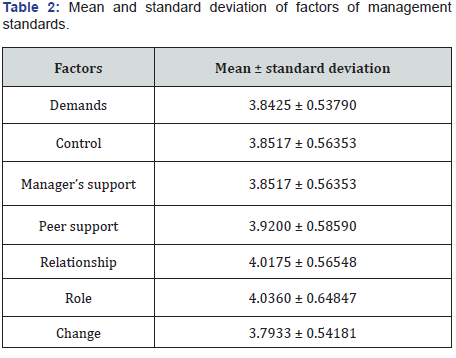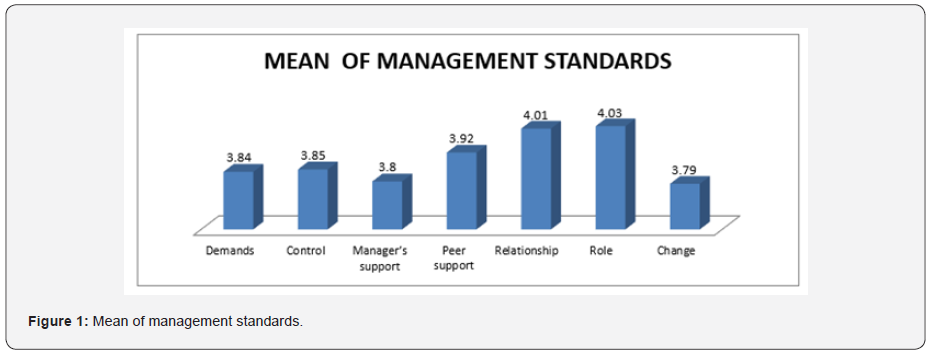Work Related Stress Among Health Care Professionals in Karachi
Shazia Tabussum1*, Ghazala Noor Nizami2, Syed Mukhtar Ahmed3, Muhammad Asif4, Hina Rathi5 and Hina Muhammad Munaf6
1Assistant Professor before Department of Health, Department of Health, University of Karachi, Physical Education and Sports Sciences, Pakistan
2Associate Professor & Principal, Jinnah College of Rehabilitation Sciences, Sohail University, Pakistan
3Physiotherapist, Institute of Physiotherapy and Rehabilitation Sciences, Liaquat University of Medical and Health Sciences Jamshoroo, Sindh Pakistan
4Department of Rehabilitation and Health Sciences,Nazeer Hussain University, Pakistan
5Assistant Professor, Suleman Roshan College of Physiotherapy and Rehabilitation Sciences, Tando adam, Pakistan
6DOW University of Health Sciences, Pakistan
Submission:February 03, 2021; Published:February 17, 2021
*Corresponding author: Shazia Tabussum, Department of Health, University of Karachi, Physical Education and Sports Sciences, Pakistan
How to cite this article: Shazia T, Ghazala Noor N, Syed Mukhtar A, Muhammad A, Hina R, et al. Work Related Stress Among Health Care Professionals in Karachi. J Phy Fit Treatment & Sports. 2021; 8(5): 555747. DOI: 10.19080/JPFMTS.2021.07.555747
Abstract
Objective: To explore the work-related stress among health care professionals in Karachi.
Design: A Cross-sectional study.
Method: A validated questionnaire was used in this study to find out the work-related stress among health care professionals. Sample size of this study was 100. Data was analyzed by SPSS version 21.
Result: Out of 100 health care professionals 55% were male and 45% were female. Mean age was 40.66 ± 12.25 while mean of working experience was 14.58 ± 11.77. Role and relationship scale scores highest Mean 4.0360 ± 0.64847 & 4.0175 ± 0.56548, respectively. Change scale and manager’s support scores least mean; 3.7933 ± 0.54181 & 3.8517 ± 0.56353, respectively.
Conclusion: Study concluded that change and manager’s support score a least mean and needs improvement while role and relationship score highest mean among all factors of work-related stress.
Keywords: Work-related stress, health care professionals, Etiology
Introduction
Stress is one of the most severe occupational risks and according to world health organization “work related diseases are a wide spectrum of disease of multifactorial etiology which is partly associated with profession or working condition”.[1]. Stress can be cause by acute or chronic physical and psychosocial stressors related with both personal and work lives [2]. Health care professionals usually effected with workplace stress due unique work responsibilities. Workplace stress led to decline in health status, work related injuries, [3] worker-burnout and several physical and emotional problems [4]. Poor physical and mental outcomes are associated with high workload, conflict with colleagues, high job demands, poor supervision and lack of support [5]. Health care profession is the one of the most demanding profession which faces and works under stress full environment to improve quality and productivity [6]. Stress occurs when individual feel that they cannot cope with the demands of work due to lack of experience, work ability or personality [7]. Work related stress occurs when conflict arises from the job demands and employees unable to handle it properly, the stress can become distress [8].
Researchers identified six work-related stressors; demands, control, support, relationship, role, and change. These six categories of work-related stressors negatively impact on health care practitioner’s wellbeing and efficiency [9]. The Control scale shows the way individual works. Demands scale shows workload, work patterns and work environment, role scale shows whether individual understands his role within organization, “change scale” indicates how organizational change is managed and communicated in the organization, “peer Support’’ includes the encouragement, sponsorship and resources provided by colleagues, managers support’ focused on the support provided by the organization and relationships scale includes promoting positive working to avoid conflict and dealing with unacceptable behavior [10].
Methods
A cross sectional study was conducted to measure the workrelated stress among health care professionals. 100 health care professionals participated in the study. Data was collected from physicians, orthodontist, and physical therapist. Informed consent was taken before collecting data. Data was collected through health and safety executive management standard stress indicator tool. Questionnaire consist of 35 items answered through a five-point Likert scale, and covering seven domains; control scale (items 5, 6, 19, 23, 29, and 34), demands scale (items 7, 10, 9, 13, 20, 22, 24, and 26), role scale (items 8, 14, 15, 17, and 21), change (items 30, 32, and 36), peer support (items 11, 28, 31, and 35), managers support (items 12, 27, 33, 37, and 39, relationships scale (items 9, 18, 25, and 38). Data was analysis through SPSS version 21 and Microsoft excel. Mean and percentile was calculated.
Results
In present study 100 health care professionals were participated in which 55% were male and 45% were female. Mean value of age of participants are 40.66 ± 12.25 while mean value of experience of the participants was 14.58 ± 11.77. Table 1 shows the percentile of different factors of management standards. Values of below 20th percentile shows higher work-related stress and need urgent action, values in between 20th-50th percentile shows average work-related stress but need improvement, values in between 50th-80th percentile shows good performance but potential improvement while values above 80th percentile doing very well and need to maintain performance Table 2.


Discussion
Results of present study show moderate level of stress among health care professionals; change and manager’s support score a least mean among all factors of work related stress. A study conducted on school teachers explored high level of work related stress [11] while in another study job stress reported moderately higher than other studies. [2] Study explored that level of work related stress is higher among physician working in hospitals as compared to heath care physicians. Work control and demand domains score highest among all domains of work related stress [7]. In present study role and relationship domains score highest mean among all the domains. Another study explored that the factors increases work related stress are insufficient number of co-workers, lack of communication with superiors and work resources among midwives but their work ability in relation to the work demands was good. [12] Al-Omar indicates that work related stress seem higher and main factors are insufficient technical facilities, absences of appreciation and long working hours.(4) Relationship and peer support exceeded national standards while demand and change need improvement [13] Al‑Makhaita et al, in 2014 reported high level of work related stress among nurses [8]. Robert Kerr identified in 2009 that control and peer support had no significant relationship with job related stress or depression while manager’s support had a modest relationship [10]. In another study researcher concluded that demand of the job, practice administration, interference with family life and patient’s expectation is the main stressors of work related stress. [14] Researcher found relationship with colleagues; responsibility and appreciation for their work were the highest level of satisfaction. [15] In 2013 study reported workload, working conditions and sleep deprivation were the most important source of stress and workload, nightshift and peer support had a positive association with level of stress [16]. In 2017, study explored that doctors are serious sufferers of organizational role stress [17]. Study reported moderate level of stress among nurses especially in those who were engaged in physical activity [18]. In 2012 study conducted by Tsai & Liu indicated high demands, low level of social support and little decision making authority were the main factors associated with work related stress [19]. In present study score of managers support and work demand domain are low while relationship and role related to work are higher among all other domains.

Conclusion
Present study concluded that majority of the health care professional have good understanding about their role in organization and they have good relationship with their colleagues, but they have moderate level of understanding about the demands of their work, change and manger’s supports.
References
- Milutinovic D, Golubovic B, Brkic N, Prokes B (2012) Professional stress and health among critical care nurses in Serbia; Arh Hig Rada Toksikol 63: 171-180.
- Yeboah MA, Ansong, Henry OA, Yiranbon AA, Anyan F, et al. (2014) Determinants of workplace stress among healthcare professionals in Ghana: An Empirical Analysis; International journal of Business and social sciences 5 (4): 140-151.
- Salam A, Abu-Helalah M, Jorissen SL, Niaz K, Mansour A, et al. (2014) Job stress and job satisfaction among health care professionals; European Scientific Journal 10(32):156-173.
- Al-Omar BA (2003) Sources of work-stress among hospital- staff at the Saudi MOH; JKAU: Econ & Adm 17(1): 3-16.
- Khamisa N, Oldenburg B, Peltzer K, Ilic D (2015) Work Related Stress, Burnout, Job Satisfaction and General Health of Nurses; Int. J. Environ. Res. Public Health (12): 652-666.
- Nishshanka WA, Akilendran K, Muraleeswaran R (2016) An Assessment of Level of work-related stress among nursing officers at districk general hospital Vavuniya in Sri Lanka. International Journal of Scientific and Research Publications 6(3): 177-180.
- Al Haddad FM, Al Mansur HM, Al Momatin YH (2016) Work-related stress in primary health care physicians and hospital physicians in Riyadh Military Hospital, Journal of Medical Science and Public Health 5(12): 2385-2393.
- Al‑Makhaita HM, Sabra AA, Hafez AS (2014) Predictors of work‑related stress among nurses working in primary and secondary health care levels in Dammam, Eastern Saudi Arabia; Journal of Family and Community Medicine 21(2): 79-84.
- Cousins R, Mackay CJ, Clarke S, Kelly C, Kelly PJ, McCaig (2004) Management standards and work-related stress in the UK: Practical development; Work & stress 18(2): 113-136.
- Kerr R, McHugh M, McCrory M (2009) HSE Management Standards and stress-related work outcomes; Occupational Medicine: 59: 574-579.
- Siddique FA (2013) Occupational stress in teachers: A comparative study of public and private schools in Hyderabad city; The Sindh University Journal of Education 42(13): 62-73.
- Knezevic B, Milosevic M, Golubic R, Belosevic L, Russo A, Mustajbegovic J (2011) Work-related stress and work ability among Croatian university hospital midwives; Midwifery: 27(2): 156-173.
- Tuthill JI, Ahmed MS, Mathew G, Bolton AC, Molokhia AA (2013) Work-related stress amongst doctors in intensive care, anaesthetics, accident and emergency and general medicine Crit Care 17(2): 508.
- Cooper CL, Rout U, Faragher B (1989) Mental health, job satisfaction, and job stress among general practitioners; Br Med J (298): 366-370.
- Antoniou AS, Cooper CL, Davidson MJ (2016) Levels of job dissatisfaction and work-related stressors experienced by medical doctors in Greek hospitals; Journal of Compassionate Health Care 3(4): 1-9.
- Aslam HD, Mansoor N, Suleman Q, (2013) Analysis of Level of Stress among Doctors in Public and Private Hospitals of Pakistan; International Journal of Learning & Development 3(2): 109-135.
- Rashid I (2012) Workplace stress among doctors in government hospital; An Empirical study; International Journal of Multidisciplinary Research 2(5): 208-220.
- Rice V, Glass N, Ogle KR, Parsian N (2014) Exploring physical health perceptions, fatigue and stress among health care professionals, Journal of Multidisciplinary Healthcare 7: 155-161.
- Tsai Y, Liu C (2012) Factors and symptoms associated with work stress and health-promoting lifestyles among hospital staff: a pilot study in Taiwan; BMC Health Services Research 12(199): 1-8.






























